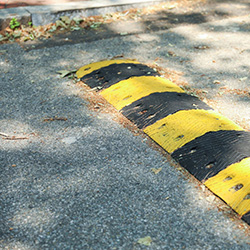Speed bumps, often seen as a simple yet effective traffic calming measure, have a significant impact on road safety and urban traffic management. These physical obstructions are designed to reduce vehicle speeds, enhance pedestrian safety, and improve the overall livability of residential and high-pedestrian areas. This article delves into the various aspects of speed bumps, including their types, benefits, implementation challenges, and future innovations.
Understanding Speed Bumps
Speed bumps are raised sections of roadways, typically 3 to 6 inches high and 1 to 3 feet wide, designed to force vehicles to slow down to a safe speed. They are most effective on roads with speed limits of 10-25 mph and are commonly found in residential areas, school zones, parking lots, and pedestrian-heavy areas.Types of Speed Bumps
- Traditional Speed Bumps: These are the most common type, found in parking lots and on private roads. They are effective at reducing speeds to around 5 mph.
- Speed Humps: Slightly longer and flatter than speed bumps, speed humps span about 10 to 14 feet, creating a gentler rise and fall. They are designed to reduce speeds to 15-20 mph and are more suitable for public roads.
- Speed Tables: These are essentially elongated speed humps with a flat top, often used at pedestrian crossings. Speed tables are effective in reducing speeds to 25 mph and provide a smoother crossing for pedestrians.
- Raised Crosswalks: Combining the features of speed tables and pedestrian crosswalks, raised crosswalks elevate the crossing area to sidewalk level, making pedestrians more visible to drivers and vehicles slower as they approach.
Benefits of Speed Bumps
The implementation of speed bumps brings several advantages, particularly in improving road safety and enhancing community livability.- Reduced Vehicle Speeds: Speed bumps are highly effective at reducing vehicle speeds in areas where high speeds are dangerous. This reduction in speed decreases the likelihood and severity of accidents.
- Enhanced Pedestrian Safety: By slowing down vehicles, speed bumps provide a safer environment for pedestrians, especially in high-traffic pedestrian areas such as school zones and residential neighborhoods.
- Improved Quality of Life: Reduced traffic speeds contribute to a quieter, more peaceful environment, which enhances the quality of life for residents in areas with speed bumps.
- Cost-Effective Solution: Compared to other traffic calming measures like traffic lights or roundabouts, speed bumps are relatively inexpensive to install and maintain.
Implementation Challenges
Despite their benefits, the implementation of speed bumps comes with certain challenges and considerations.- Emergency Vehicle Delays: Speed bumps can slow down emergency vehicles, potentially delaying response times. This is a significant concern, and some areas may opt for alternative traffic calming measures that do not impede emergency services.
- Driver Discomfort: Drivers may find speed bumps uncomfortable, especially if they are not clearly marked or if they travel over them at high speeds. This discomfort can lead to negative public perception and resistance to their installation.
- Maintenance and Wear: Over time, speed bumps can wear down and require maintenance. Poorly maintained speed bumps can become less effective and may even pose hazards.
- Noise Pollution: The sound of vehicles slowing down and speeding up over speed bumps can contribute to noise pollution, which may disturb nearby residents.
Case Studies and Real-World Applications
Several cities and communities worldwide have successfully implemented speed bumps as part of their traffic calming strategies.- Portland, Oregon: Portland has extensively used speed humps and raised crosswalks in its residential neighborhoods. Studies have shown that these measures have significantly reduced vehicle speeds and improved pedestrian safety.
- New York City, New York: New York City has implemented speed humps in various school zones, leading to a noticeable decrease in speeding incidents and an increase in pedestrian safety.
- Amsterdam, Netherlands: Known for its bike-friendly infrastructure, Amsterdam uses speed tables and raised crosswalks to protect cyclists and pedestrians, effectively integrating these measures into its comprehensive traffic management system.
Future Innovations in Speed Bump Design
Innovations in speed bump design are continually evolving to address the challenges associated with traditional speed bumps and to enhance their effectiveness.- Dynamic Speed Bumps: These are adjustable speed bumps that change height based on the speed of the approaching vehicle. For instance, they remain flat for vehicles traveling at or below the speed limit but rise to slow down speeding vehicles. This technology ensures that only speeding vehicles are penalized, minimizing discomfort for compliant drivers and emergency vehicles.
- Smart Speed Bumps: Integrating technology, smart speed bumps can communicate with traffic management systems to collect data on vehicle speeds, traffic volume, and the effectiveness of the speed bumps. This data can be used to optimize traffic flow and improve road safety.
- Eco-Friendly Materials: Advances in materials science have led to the development of speed bumps made from recycled materials or those designed to have a minimal environmental impact. These materials are not only sustainable but also durable and cost-effective.
- Interactive Speed Bumps: These speed bumps use lights and signals to alert drivers about their speed. For example, LED lights embedded in the speed bump can flash to indicate that a vehicle is traveling too fast, providing a visual cue for drivers to slow down.

